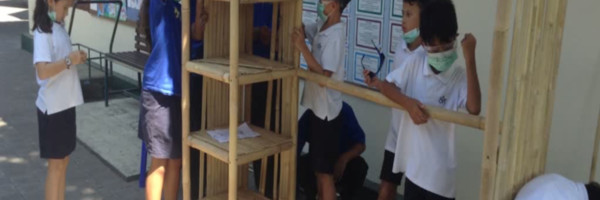New Lost and Found Centre
Dear Parents,
Here is an overview of what Mrs. Preeti and Grade 4 have been working on for the past few weeks. This article will be appearing in the Winter 2016 edition of the EARCOS magazine.
We look forward to the official opening in due course.
Mr. Lorenzini
GRADE 4 DESIGNS AND CONSTRUCTS A LOST AND FOUND PROPERTY CENTRE AS PART OF THEIR INQUIRY
The grating sounds of saws at work and of nails being drilled into hard bamboo filled the air as children totally immersed in their project, carried 30 foot poles of bamboo to makeshift stands made from chairs, measured them carefully into different lengths and sawed, drilled and hammered away.
It had been an exciting few weeks. The Grade 4 children at Bali Island School had been looking at how the design of buildings and structures was dependent on environmental factors, available materials and human ingenuity. As part of the inquiry, the children had met and interviewed two well-known architects in Bali, visited an indigenous Balinese compound, as well as a marvelous centre for yoga, built completely from bamboo. The children were curious to find out why certain materials were used for building in modern and traditional Balinese structures. So they devised many scientific experiments to test a variety of building materials for strength, insulation and water proofing qualities. This helped the students to understand their properties better. They were astonished to learn that bamboo was as strong as iron of the same mass!
The next question was how could they apply their newfound knowledge to an authentic, real life situation? The result: A desperately needed Lost and Found Property Centre for the Primary School.
The children first decided to brainstorm ideas of what had to be considered before starting the project. They looked closely at the lost property in the school to see what they had to plan for. Many questions arose that ranged from which building materials would be the most suitable to how to decide the right measurements. They wondered how different kinds of lost property would be best stored. What if it was a wet swimming costume and towel? Should they have pegs or a bar with hangers for clothes? Did they need drawers to lock valuable things or should they stick to shelves? They decided to measure bottles, bags and lost kits to understand the shelf size needed. They considered the average heights and arm lengths of the children and teachers to decide on how tall the centre should be and how deep.
Each child came up with a design using scale and the final decision was left to the primary principal who chose a design that represented a mixture of the best ideas from all the children. The children decided to use bamboo as they had learned that it was strong and sustainable as well as recycled wood from broken school furniture.
The fourth graders couldn’t wait for the time in the day when they could work on their project. Their enthusiasm to ask questions, to analyze and find solutions to problems as they came up, to apply their newly gained mathematical and scientific knowledge, to discuss their project work with anyone who would care to listen and to write about it, was palpable. In an effortless way, the children were synthesising all their learning experiences and reaching all their ‘academic benchmarks’ through real life trans disciplinary learning.
What else did the children gain from this experience? By being challenged and actively engaged in tasks that were authentic, relevant to them and significant to the entire community, this project helped to promote self-management, perseverance, and a willingness to adapt to different roles and collaborate over different ideas respectfully and assume responsibility. In short, many of the skills necessary to help our students thrive and succeed as responsible citizens in a changing world.

